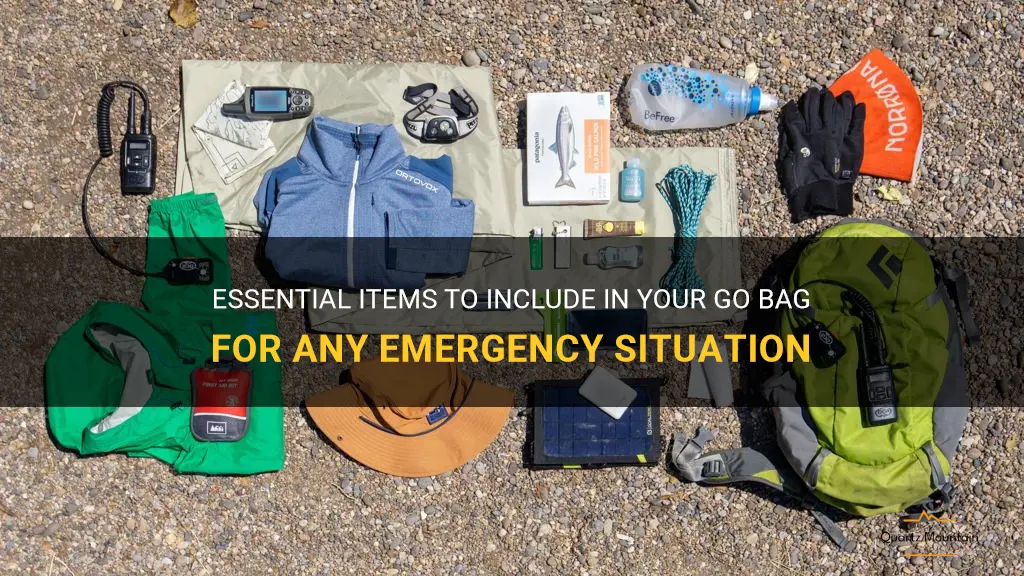
In times of uncertainty and unexpected emergencies, it is crucial to have a well-prepared go bag on hand. Whether it's a natural disaster, a sudden evacuation, or any other unforeseen situation, having the essential items in your go bag can mean the difference between survival and being caught unprepared. From food and water to first aid supplies and important documents, this comprehensive guide will help you gather all the necessary items to include in your go bag, ensuring that you are ready for whatever may come your way.
| Characteristics | Values |
|---|---|
| Water | At least 1 gallon per person per day |
| Food | Non-perishable food for at least 3 days |
| Medications | At least a 3-day supply |
| First Aid Kit | Including band-aids, gauze, and antiseptic |
| Flashlight | With extra batteries |
| Radio | Battery-powered or hand-cranked |
| Whistle | To signal for help |
| Dust mask | To help filter contaminated air |
| Moist towelettes | For personal hygiene |
| Wrench | To turn off utilities |
| Can opener | For opening canned food |
| Cell phone | With chargers and a backup battery |
| Local maps | To navigate in case of evacuation |
| Cash | In small denominations and coins |
| Important documents | Copies of identification, insurance policies, and emergency contacts |
| Change of clothes | Including durable shoes and warm clothing |
What You'll Learn
- What essential items should be included in a go bag?
- How should clothing be selected and packed for a go bag?
- What types of non-perishable food and water should be included in a go bag?
- Are there specific documents or identification that should be packed in a go bag?
- Should any special medications or first aid supplies be included in a go bag?

What essential items should be included in a go bag?
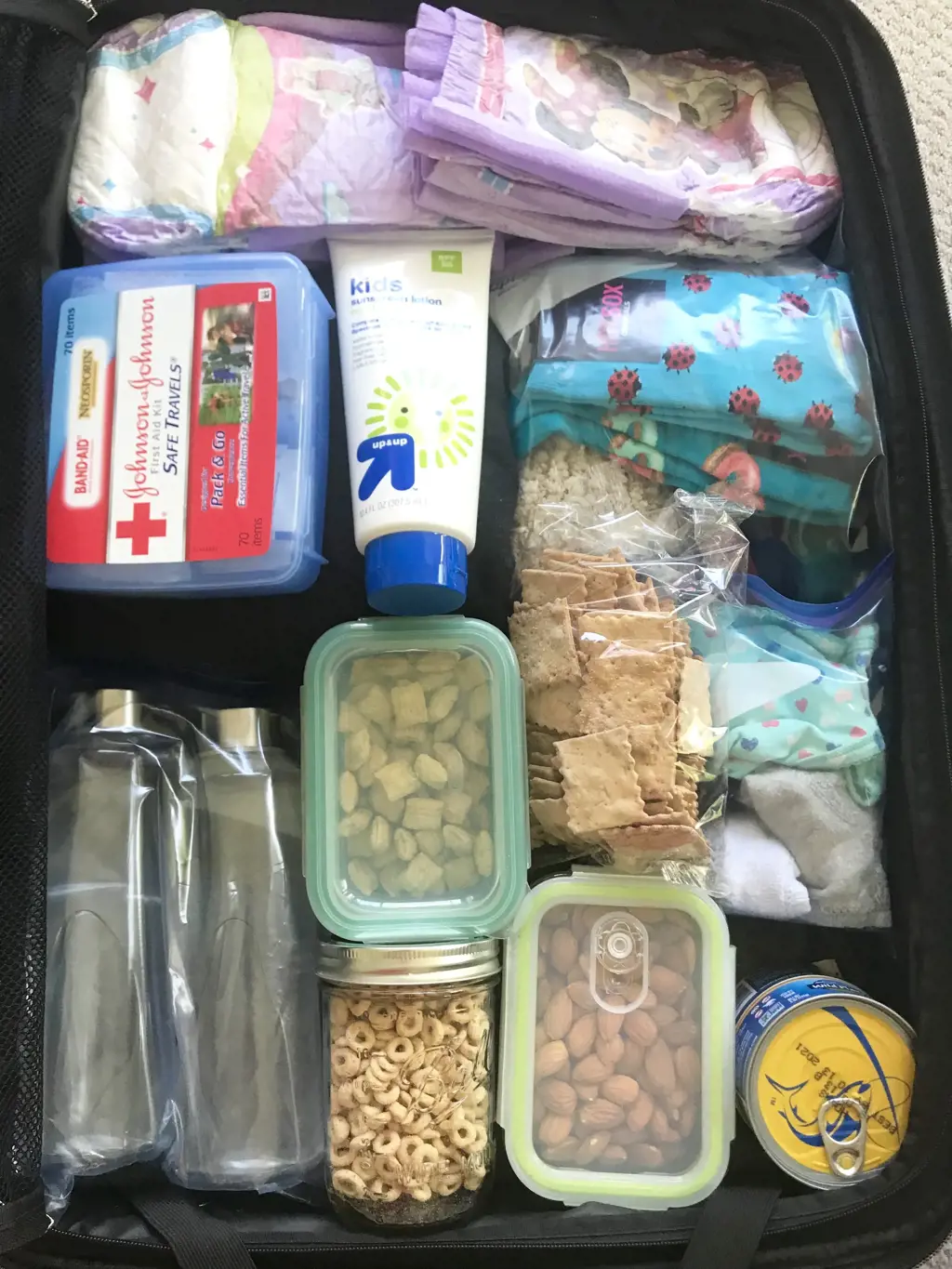
A go bag, also known as a bug-out bag or emergency kit, is a collection of essential items that you can grab quickly in case of an emergency or disaster. It is important to have a well-equipped go bag that can sustain you for at least 72 hours. Whether you are facing a natural disaster, a medical emergency, or any other unforeseen event, having a go bag can make a huge difference in your preparedness and survival. Here are some essential items that should be included in a go bag:
- Water: One of the most important items in your go bag should be water. It is recommended to have at least one gallon of water per person per day for drinking and sanitation purposes.
- Food: Pack non-perishable food items that do not require cooking or refrigeration. Examples include energy bars, canned goods, and dried fruits. Make sure to pack enough food to last you for at least 72 hours.
- First aid kit: A well-stocked first aid kit is crucial in any emergency situation. It should include bandages, antiseptic ointment, painkillers, and any necessary prescription medications. It is also a good idea to include a basic manual on first aid procedures.
- Flashlight and extra batteries: In the event of a power outage, a flashlight can be a lifesaver. Make sure to pack extra batteries as well.
- Radio: A battery-powered or hand-cranked radio will allow you to stay informed about the latest news and updates during an emergency.
- Personal hygiene items: Include items such as toothpaste, toothbrushes, soap, and toilet paper. These items will help you maintain hygiene even in challenging situations.
- Money and important documents: Keep some cash in your go bag, as ATMs may not work during a disaster. Also, include copies of important documents like identification cards, insurance papers, and contact information.
- Clothing and blankets: Pack a change of clothes, including sturdy shoes and extra socks. Additionally, include blankets or sleeping bags to keep you warm in case you find yourself without shelter.
- Tools: Pack a multi-tool, duct tape, and a whistle. These items can be useful for a variety of purposes, such as repairing equipment or signaling for help.
- Personal items: Include any necessary personal items, such as a spare set of glasses or contact lenses, medications, and a list of emergency contacts.
Remember to regularly check and refresh the items in your go bag to ensure their effectiveness and expiration dates. Additionally, customize your bag according to your specific needs and geographical location. Consider any specific requirements you may have, such as special dietary needs or medical conditions.
In conclusion, a go bag is an essential item to have in case of emergencies or disasters. It should contain water, food, a first aid kit, a flashlight, a radio, personal hygiene items, money and important documents, clothing and blankets, tools, and personal items. By being prepared and having a well-equipped go bag, you can increase your chances of survival and ensure your comfort during challenging times.
Essential Items to Pack for a Trip to Bahamas
You may want to see also

How should clothing be selected and packed for a go bag?
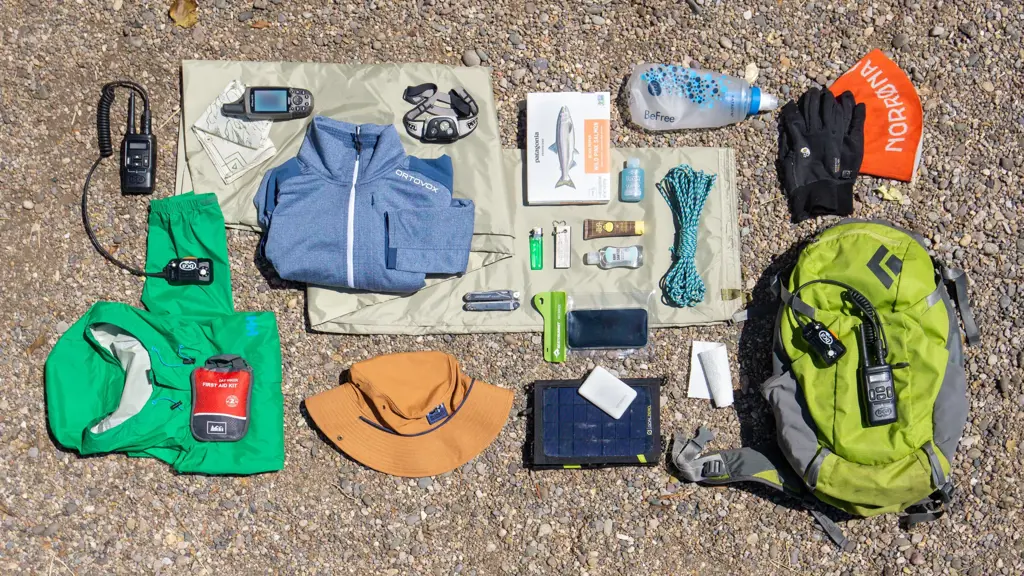
When putting together a go bag, it's important to consider what clothing to include and how to pack it efficiently. A go bag, also known as a bug-out bag or emergency kit, is a backpack or duffle bag filled with essential items that can sustain you during an emergency situation or when you need to evacuate quickly. Here are some tips on selecting and packing clothing for a go bag.
- Think about the climate: Consider the climate of your region and pack clothing suitable for that season. If you live in a cold climate, include warm layers such as thermal underwear, fleece jackets, and hats. In hot climates, pack lightweight and breathable clothing like shorts, t-shirts, and sun hats.
- Prioritize comfort and functionality: Choose clothing that is comfortable to wear and allows for easy movement. Opt for items with stretch or elastic waistbands. Look for moisture-wicking fabrics that dry quickly, especially if you anticipate being active or encountering wet conditions. Tactical or outdoor clothing brands often offer clothing specifically designed for durability and comfort in challenging environments.
- Layering is key: Pack clothing that can be layered to adapt to changing weather conditions. Layering allows you to regulate body temperature by adding or removing layers as needed. Include items like long-sleeve shirts, sweaters, and waterproof jackets that can be worn together or separately.
- Choose versatile items: Select clothing pieces that can be mixed and matched to create multiple outfits. This helps maximize the use of limited space in your go bag. Choose neutral colors that can easily be coordinated. Consider packing convertible pants, which can be worn as pants or shorts, to save space.
- Pack spare underwear and socks: Don't forget to include extra underwear and socks in your go bag. These items are essential for personal hygiene and comfort. Look for moisture-wicking and antimicrobial fabrics to minimize discomfort and odors.
- Consider specialized gear: Depending on your specific needs or activities, you may want to pack specialized items such as hiking boots, sturdy gloves, or a swimsuit. Think about the potential scenarios you may encounter and pack accordingly.
- Use vacuum-sealed bags: To save space and keep your clothing organized, use vacuum-sealed or compression bags. These bags remove excess air, making your clothing more compact. They also protect your clothes from moisture and insects.
- Regularly rotate clothing: It's important to regularly rotate the clothing in your go bag to ensure it remains up-to-date and appropriate for the current season. Consider checking your go bag every six months and replacing any items that are worn out or expired.
Example: Let's say you live in a region with mild winters and hot summers. Your go bag should include a combination of warm and cold-weather clothing. You could pack a lightweight jacket, a rain poncho, a few t-shirts, a long-sleeve shirt, convertible pants, a pair of shorts, thermal underwear, and a hat. Make sure to include spare underwear and socks. Use vacuum-sealed bags to compress the clothing and create more space for other essential items.
In conclusion, when selecting and packing clothing for a go bag, it's important to consider the climate, prioritize comfort and functionality, layer your clothing, choose versatile items, pack spare underwear and socks, consider specialized gear, use vacuum-sealed bags, and regularly rotate your clothing. By following these guidelines, you'll be prepared for any emergency situation that may arise.
The Art of Choosing: A Woman Contemplates What to Pack
You may want to see also

What types of non-perishable food and water should be included in a go bag?
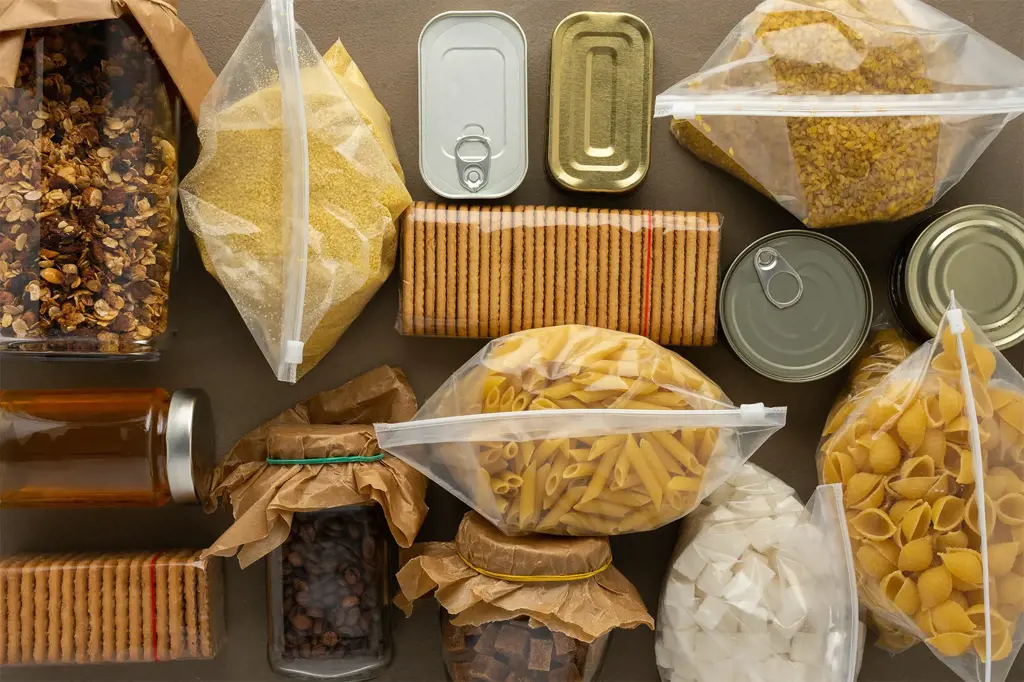
A go bag, also known as a bug-out bag or emergency kit, is a backpack or bag filled with essential items that can sustain an individual or family for at least 72 hours in the event of an emergency or disaster. One of the most important components of a go bag is non-perishable food and water. These supplies are crucial for survival when access to fresh food and clean water is limited or unavailable. Here are some types of non-perishable food and water that should be included in a go bag:
- Canned goods: Canned foods are an excellent choice for emergency situations because they have a long shelf life and are easy to store. Some examples of canned goods that should be included in a go bag are canned meat (such as tuna or chicken), canned beans, canned fruits, and canned vegetables. These can be consumed directly from the can or heated over a portable stove.
- Dried foods: Dried foods are lightweight and take up little space, making them ideal for a go bag. Some examples of dried foods that should be included are dried fruits, jerky, trail mix, and granola bars. These foods provide essential nutrients and energy and can be eaten as snacks or added to water for rehydration.
- Energy bars: Energy bars are compact, calorie-dense, and provide a quick source of energy. Look for energy bars that are high in protein, fiber, and healthy fats. These bars can help sustain you during an emergency and can be easily consumed on the go.
- Bottled water: Water is essential for survival, and it is crucial to include an adequate supply in a go bag. It is recommended to have at least one gallon of water per person per day for drinking and sanitation purposes. Bottled water is convenient and easy to store in a go bag. Alternatively, you can also include water purification tablets or a portable water filter to purify water from natural sources if needed.
- Powdered drink mixes: Powdered drink mixes can help improve the taste of stored water and provide necessary electrolytes during an emergency. Look for drink mixes that are high in Vitamin C and have added electrolytes to help replenish nutrients lost through sweating and physical exertion.
- Instant coffee or tea: For those who rely on caffeine, having instant coffee or tea in a go bag can provide a much-needed boost. Individual packets or sachets are lightweight and easy to store, making them a convenient choice for emergency situations.
It is important to regularly check the expiration dates of the non-perishable food items in your go bag and replace them as needed. Additionally, consider individual dietary restrictions, allergies, and preferences when choosing the types of food and water to include in your go bag.
In conclusion, a go bag should contain a variety of non-perishable food and water to sustain you during an emergency or disaster. Canned goods, dried foods, energy bars, bottled water, powdered drink mixes, and instant coffee or tea are essential items to include. Remember to regularly check expiration dates and personalize the contents of your go bag based on individual needs and preferences. By being prepared with enough food and water, you can increase your chances of survival during unexpected emergencies.
Essential Packing List for an Unforgettable Two-Week Cruise in the French Polynesian Islands
You may want to see also

Are there specific documents or identification that should be packed in a go bag?
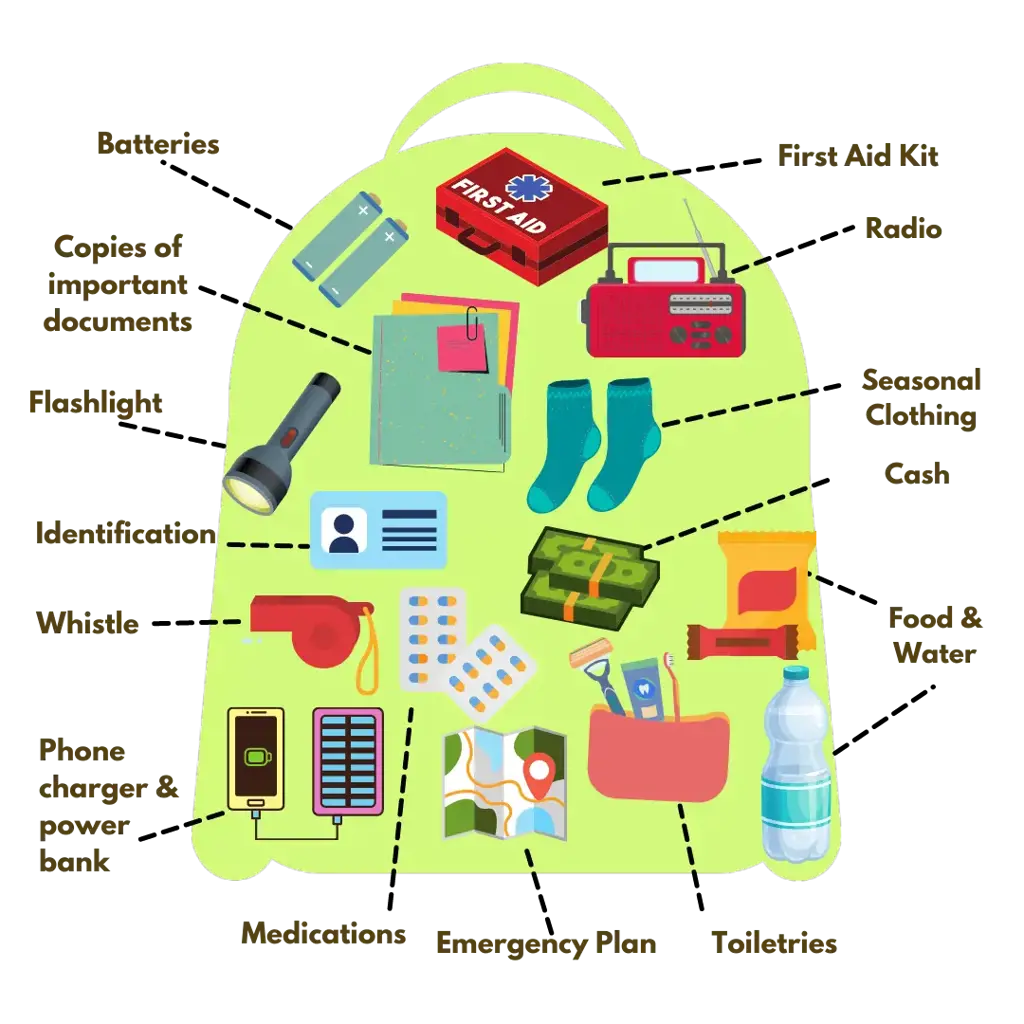
When putting together a go bag, it is important to include specific documents and identification to ensure preparedness for any emergency situation. These documents can provide crucial information and assistance in various scenarios, such as natural disasters, evacuations, or sudden emergencies. In this article, we will explore the necessary documents and identification that should be packed in a go bag.
Personal identification documents:
- Driver's license or identification card: This form of identification is essential for proving your identity and may be required for various tasks during an emergency, such as accessing emergency shelters or claiming insurance benefits.
- Passport: If you have a passport, it is advisable to include it in your go bag. This document can be useful for identification purposes, especially if you need to travel internationally or on short notice.
- Social Security card or proof of social security number: Having your social security card or a document containing your social security number can be necessary when dealing with government agencies, insurance claims, or other official matters.
Medical information:
- Health insurance card: It is crucial to have your health insurance card handy in case you need medical treatment during an emergency. This card contains essential information about your coverage and can ensure uninterrupted access to medical services.
- List of emergency contacts: Include a list of emergency contacts, including family members, friends, or medical professionals. This can help first responders or medical personnel quickly reach your loved ones in case of an emergency.
- Medical history and prescriptions: If you have any chronic illnesses or take prescription medications, it is advisable to have a copy of your medical history and a list of current prescriptions. This information can be vital for medical professionals if you require medical help away from your regular healthcare providers.
Financial and legal documents:
- Cash: It is prudent to include a small amount of cash in your go bag. During emergencies, ATMs and credit card machines may not be operational, and having some cash can enable you to purchase essential items or services.
- Copies of important documents: Make copies of essential documents, such as birth certificates, marriage certificates, property deeds, and vehicle titles. These documents can be important when dealing with legal or financial matters after an emergency.
- Insurance policies: Gather copies of your insurance policies, including home, auto, and health insurance. These policies contain vital information about coverage and contact details required for filing claims in case of damage or loss.
Miscellaneous items:
- USB drive or external hard drive: Save important documents, such as scanned copies of identification, medical records, and insurance policies, on a USB drive or external hard drive. This ensures that you have a backup of crucial documents that can be accessed even if physical copies are lost or damaged.
- Recent photographs: Include recent photographs of yourself and your family members in case you need to be separated or reunited during an emergency. These photographs can be helpful for identification purposes and can expedite the reunification process.
- Emergency contact information: Write down important phone numbers and addresses, including your designated meeting places, emergency services, and local authorities. This information can be critical when communication systems are disrupted.
Remember to store these documents in a waterproof and durable container within your go bag. Consider making additional copies and storing them in a secure location outside your home, such as a safe deposit box or with a trusted relative or friend. Regularly update your go bag to ensure that all documents are current and reflect any changes in personal information or circumstances.
In conclusion, packing specific documents and identification in your go bag is crucial for preparedness during emergencies. By including personal identification, medical information, financial and legal documents, and miscellaneous items, you can ensure that you have the necessary information and resources to navigate through various emergency situations. Stay vigilant, keep your go bag updated, and be prepared for any eventuality.
Ultimate Checklist for Packing for a Ballroom Competition
You may want to see also

Should any special medications or first aid supplies be included in a go bag?
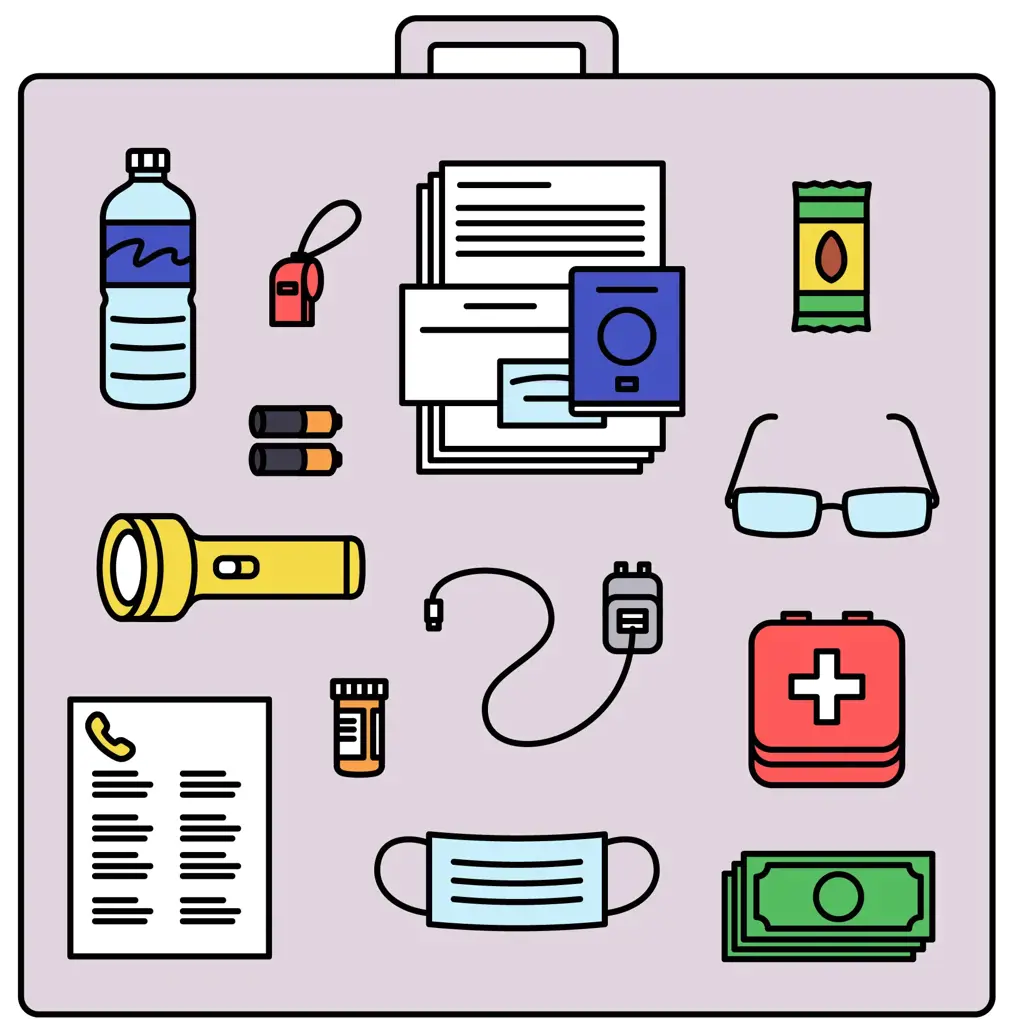
When putting together a go bag, it is important to consider all possible scenarios that may arise during an emergency situation. This includes ensuring that any special medications or first aid supplies are included in the bag.
Medications are essential for individuals with chronic conditions such as diabetes, asthma, or heart disease. It is crucial to have a sufficient supply of these medications in the go bag. The amount of medication included should be enough to last at least a few days or until help can be accessed. It is also recommended to have an updated list of medications, including dosages, in case of the need for emergency medical assistance.
In addition to regular medications, it is also important to include any specialized supplies that may be needed for specific conditions. For example, individuals with diabetes should have their insulin, glucose testing supplies, and an extra set of needles or pens in their go bag. Those with allergies should include an EpiPen, while individuals with respiratory conditions such as asthma should have their inhalers readily available.
First aid supplies are also crucial in a go bag. Basic items such as band-aids, adhesive tape, antiseptic wipes, and gauze pads should be included to treat minor cuts and injuries. It may also be useful to include over-the-counter medications such as pain relievers, antacids, and anti-diarrheal medications in case of common ailments. Some individuals may require additional supplies such as prescription-strength pain medication or specialized wound care products. It is important to consult with a healthcare professional to determine the specific needs of an individual and include the necessary supplies in the go bag.
When packing medications and first aid supplies in a go bag, it is important to consider their shelf life. Many medications have expiration dates, and it is crucial to periodically check and update the supplies in the bag. It is recommended to rotate any perishable items, such as insulin or antibiotic ointments, regularly to ensure their effectiveness.
Lastly, it is important to store medications and first aid supplies in a waterproof container or bag to protect them from moisture. This can help prolong their shelf life and ensure they are effective when needed the most.
In conclusion, including special medications and first aid supplies in a go bag is crucial for individuals with chronic conditions or specific medical needs. It is important to have a sufficient supply of medications and any necessary specialized supplies. Regularly checking and updating the supplies, as well as storing them in a waterproof container, will help ensure their effectiveness during emergency situations.
Essential Items to Pack in Your Hospital Delivery Bag
You may want to see also
Frequently asked questions
In your go bag, you should include essential items such as bottled water, non-perishable food items, a flashlight with extra batteries, a first aid kit, a portable phone charger, a multi-tool, a portable radio, and any necessary medications. It's also important to pack important documents like identification cards, passports, and contact information for family members or emergency services.
Yes, it is recommended to pack a change of clothing in your go bag. Choose lightweight and durable clothing that can be layered for different weather conditions. Consider including a jacket, extra socks, and sturdy walking shoes or boots. Don't forget to pack extra underwear and a hat for sun protection.
It's recommended to pack at least one gallon of water per person per day. This should be enough for drinking and basic hygiene needs. If you have limited space in your go bag, consider including water purification tablets or a water filter as a backup option.
It's important to review and update your go bag contents at least once a year or as needed. Check expiration dates on food, medications, and batteries, and replace them accordingly. Review your emergency contact information to ensure it is up to date. Also, consider any changes in personal needs, such as new medications or additional family members, and adjust your go bag supplies accordingly.
Absolutely! While it's important to include the essentials in your go bag, you can personalize it with additional items based on your specific needs or preferences. For example, you may want to include a small comfort item like a favorite book or a family photo, a deck of cards, or a notepad and pen for taking notes. However, be mindful of space and weight limitations, as you want your go bag to be easy to carry and transport in case of an emergency.







